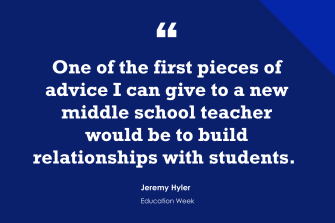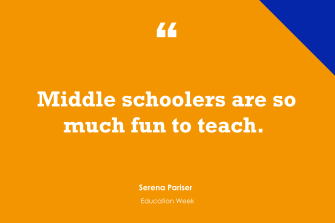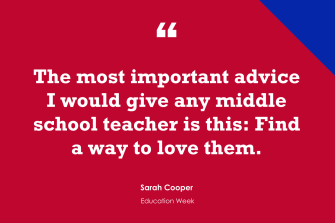(This is the first post in a two-part series.)
The new question of the week is:
What advice would you give to new (or veteran!) middle school teachers?
I spent my first year teaching in a middle school and I quickly made the move to high school. I should have gotten a lot more advice—like what contributors in this series have to offer—than I did that first year.
Today, Jeremy Hyler, Serena Pariser, Sarah Cooper, and Keturah Proctor share their experiences. Jeremy and Serena were also guests on my 10-minute BAM! Radio Show. You can also find a list of, and links to, previous shows here.
Relationships
Jeremy Hyler is a middle school English and science teacher in Michigan. He has co-authored Create, Compose, Connect! Reading, Writing, and Learning with Digital Tools (Routledge/Eye on Education) and From Texting to Teaching: Grammar Instruction in a Digital Age, as well as Ask, Explore, Write. Jeremy blogs at MiddleWeb. He can be found on Twitter @jeremybballer and at his website jeremyhyler40.com:
I almost feel there should be a brochure or a handbook given to new middle school teachers before they even think about starting their first day. Needless to say, I was only ever given one piece of advice, and that was to keep them busy, or they would eat me alive. The teacher that gave me that advice meant well as a great mentor, but as I look back, it probably wasn’t the best advice.
For me, one of the first pieces of advice I can give to a new middle school teacher would be to build relationships with students. Take interest in them as a person. Don’t just focus on their academic strengths but take time and go to their sporting events. Ask them about what they like to do outside of school, too. If they like to fish or hunt, ask them to show you pictures of their fish or deer. Be involved with them more than just being their teacher.
Also, something that goes along with building relationships is being open and honest with your students. If you make a mistake, tell them. They will respect you more if you just admit you make mistakes like everyone else does. Furthermore, I would recommend telling your students when you have a bad day. It is amazing how many times my students lift me up and help me when I am not having the greatest day. It’s about showing them you are human and real, not a person that always has a great day.
Finally, take time for yourself. Don’t be afraid to leave work on time Friday or leave that stack of papers at school. It is important to take care of yourself and to just forget about your job for some time. If you don’t take time for yourself, burnout is inevitable. Take a walk, go to the movies, or go for a drive. Whatever you decide to do, you need to make time for yourself to stay energized.

Self-Care
Serena Pariser is the bestselling author of Real Talk About Classroom Management: 50 Best Practices That Work and Show You Believe in Your Students and Real Talk About Time Management: 35 Best Practices, both published by Corwin Press:
Middle schoolers are so much fun to teach. They are curious, excited about life, bright-eyed and bushy-tailed. They are going through so much in their personal and social lives that one day can be so different from the next.
They also have a lot going on. They are learning to regulate their emotions, understand deep friendships, trying to figure out the world, and are attempting to be more independent in life. They are in this short-lived place where they are older than children but younger than what most consider a teenager. Sometimes, that can lead to a bit of a teeter-tottering of emotions that may follow them to class as they strive to be understood. As teachers of middle school students, you can find yourself making fun and engaging lessons where students are collaborating, competing, experimenting, and often creating. You’ll get to use your skill, pizazz, and energy. The advice I’d give to new or veteran middle school teachers is start the school year off with a self-care plan.
When we take care of ourselves, it shows up in our work and vice versa. Our students notice and need to be the best version of themselves. We give so much to middle schoolers that we have to remember to also give to ourselves. Middle schoolers, especially, deserve a teacher that is well-balanced and rested.
This could look like having a set of workout clothes on our bed (if we are teaching virtually) so we know to change directly in them after class. Or, if we are in a classroom, this could be as simple as bringing a set of workout clothes to class and changing before we leave school so we don’t go home and melt into the couch. That can too easily happen. Self-care could look like always keeping our water on our desks so we stay fully hydrated. It could also look like scheduling an at-home yoga video into our calendars just as you would a parent meeting. Or this could simply look like asking a colleague to be a workout buddy to hold each other accountable. Here’s a self-care inventory I created that you can use weekly, monthly, or whenever you feel the need to take a read on your self care.
When I was a first-year 6th grade teacher, I stayed late one night to grade a pile of papers that were on my desk. At 9 p.m., my principal walked by my class and saw my light on. He said just two words to me, “Go home.” He knew this is how teachers lose steam and eventually could burn out. My self-care was completely out of whack that year, and if I could get a time machine and travel back to my first year, I would have done much better if I took time to take care of myself. We can’t pour from empty cups. The thing about self-care is we should do it before we need it and keep our cups full. My advice would be to simply make self-care a proactive practice, not a reactive fix.

‘Love Them’
Sarah Cooper teaches 8th grade U.S. history and is the dean of studies at Flintridge Preparatory School in La Canada, Calif. Sarah is the author of Making History Mine: Meaningful Connections for Grades 5-9 (Stenhouse, 2009) and Creating Citizens: Teaching Civics and Current Events in the History Classroom, Grades 6-9 (Routledge, 2017). All of her recent writing can be found at sarahjcooper.com:
After more than two decades of teaching middle school, my answer has simplified over time.
Twenty years ago, I would have said that you need to keep students busy, change up activities multiple times a period, make sure they’re doing something. Ten years ago, I would have said that you need to see the infinite potential of middle schoolers and treat them as the fledgling young adults they are, complete with profoundly felt opinions and a desire to improve the world.
And I would still agree with both of these points.
But now, maybe because I realized anew during our recent period of online learning how meaningful it is for us to be in community together, the most important advice I would give any middle school teacher is this:
Find a way to love them.
For new teachers with shaky lesson plans, for veteran teachers with fatigue behind their eyes, this is the first and most important step. If your students feel that you’d rather be teaching high school and are just marking time with them, they’ll resent you. If they sense that their craziness drives you crazy, and not in a joking kind of way, they’ll slog into their seats.
But if you can laser through their messiness, floppiness, awkwardness, perfectionism, socializing, and so much else to understand that they are figuring themselves out, that’s your toehold in. For one colleague, this means accepting that her classes are just going to be loud, and she’s OK with that. For another, it’s creating a massive simulation that harnesses everyone’s talents and skills. For me, it’s coming into class, taking a breath and riding the wave of energy like a surfer—then grappling with hard current and historical issues, listening to my students’ opinions as they inform each other’s and my own.
If you can discover this toehold, you’ll secure a front-row seat to these young adolescents’ identity development and might even be able to help some of them in their journey. Many or all of them will probably accept you back. And, by the end of the year, some of them might even love you back—if you’re lucky!

‘Don’t Believe the Myths’
Keturah Proctor has had over 20 years of experience in education advocating for students through an anti-bias, anti-racist lens:
Don’t believe the myths about middle school students. From grades 5-8, students experience tremendous growth and change. Physically, they are changing. Socially, they are having to put themselves out there in a way they’ve never had to before. Academically, school is becoming more difficult, so students now have to manage their time and their study habits and their schedules. Emotionally, they are experiencing new feelings and may not have the words to communicate them. These years are full of tremendous highs and good feelings and tremendous lows when students are developing their resilience in order to navigate.
Middle school teachers, show your humanity, your personality, your individuality—middle school students want to know that you are a person, too. Their need for connection and validation is reinforced when they know that you, too, are being vulnerable.
As a middle school teacher, you should remove yourself from the center as the “all-knowing teacher” and position yourself as someone who is guiding young people. You have to learn to share the space with young people. Middle school students want independence. They want the room to discover, wonder, and to express themselves. As the teacher, you must be able to cultivate the environment where discovery is welcomed and celebrated.
Young people want to know that you believe in them and are rooting for them. Even when they make mistakes, that should be welcomed, because making mistakes is part of growing. Middle school students need to understand that they are safe to express who they are and encouraged to find out who they want to be. Individuality is a big part of middle school. Student expression and identity are a big part of the middle school years, and as a middle school teacher, you have to be prepared for that. You have to honor that students are coming in with their own lived experiences and are questioning, exploring, and affirming who they are and who they are becoming. As a middle school teacher, you have to be committed to learning, not just the content, but committed to learning and understanding young people, their perspectives, and their realities.
Learning to not only welcome student voice but provide space to cultivate it and for students to recognize their own brilliance and power. Provide a learning environment where each student feels like it was created for them. This means that you are going to find points of connection, authentic points of connection. It means immersing yourself in everything that young people are immersed in. Middle school teachers should develop an understanding of what students are experiencing, not only while at school but outside of school. It means knowing what’s happening on social media and learning about the dances, the styles, the music of young people. It means understanding what young people care about and what is important to them.
Being a middle school teacher means unlearning what it means to be “the teacher” and to develop an understanding that you are there to guide young people on their journey, by validating and affirming their discovery of self. Being a middle school teacher is about conveying academic content in a dynamic manner and being authentically engaged with students as they are walking through their journey of self-discovery.
I’ve taught 6th grade for over 20 years. In that time, I realized that my success had nothing to do with the instructional content, but it had everything to do with developing relationships with students where they saw that I was genuinely connected to them as people, not just my students. It meant including my students and valuing their input rather than just seeing them as passive receptors of information. We focused on community building and honoring the gifts and individuality of one another. That understanding was the north star for students to be able to realize that their actions and behavior have not just an impact on them personally, but that they are part of something bigger, allowing for reflection as to how everyone in the learning community is responsible for one another.

Thanks to Jeremy, Serena, Sarah, and Keturah for contributing their thoughts.
Consider contributing a question to be answered in a future post. You can send one to me at lferlazzo@epe.org. When you send it in, let me know if I can use your real name if it’s selected or if you’d prefer remaining anonymous and have a pseudonym in mind.
You can also contact me on Twitter at @Larryferlazzo.
Education Week has published a collection of posts from this blog, along with new material, in an e-book form. It’s titled Classroom Management Q&As: Expert Strategies for Teaching.
Just a reminder; you can subscribe and receive updates from this blog via email (The RSS feed for this blog, and for all Ed Week articles, has been changed by the new redesign—new ones are not yet available). And if you missed any of the highlights from the first 10 years of this blog, you can see a categorized list below.
- The 11 Most Popular Classroom Q&A Posts of the Year
- Race & Racism in Schools
- School Closures & the Coronavirus Crisis
- Classroom-Management Advice
- Best Ways to Begin the School Year
- Best Ways to End the School Year
- Student Motivation & Social-Emotional Learning
- Implementing the Common Core
- Challenging Normative Gender Culture in Education
- Teaching Social Studies
- Cooperative & Collaborative Learning
- Using Tech With Students
- Student Voices
- Parent Engagement in Schools
- Teaching English-Language Learners
- Reading Instruction
- Writing Instruction
- Education Policy Issues
- Assessment
- Differentiating Instruction
- Math Instruction
- Science Instruction
- Advice for New Teachers
- Author Interviews
- The Inclusive Classroom
- Learning & the Brain
- Administrator Leadership
- Teacher Leadership
- Relationships in Schools
- Professional Development
- Instructional Strategies
- Best of Classroom Q&A
- Professional Collaboration
- Classroom Organization
- Mistakes in Education
- Project-Based Learning
I am also creating a Twitter list including all contributors to this column.





